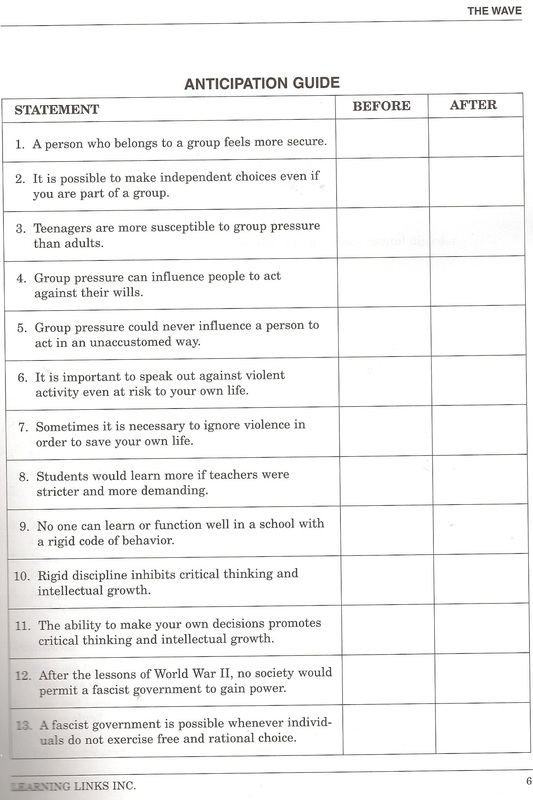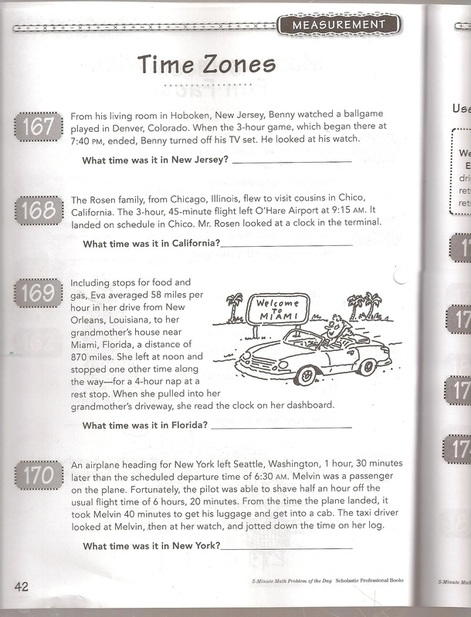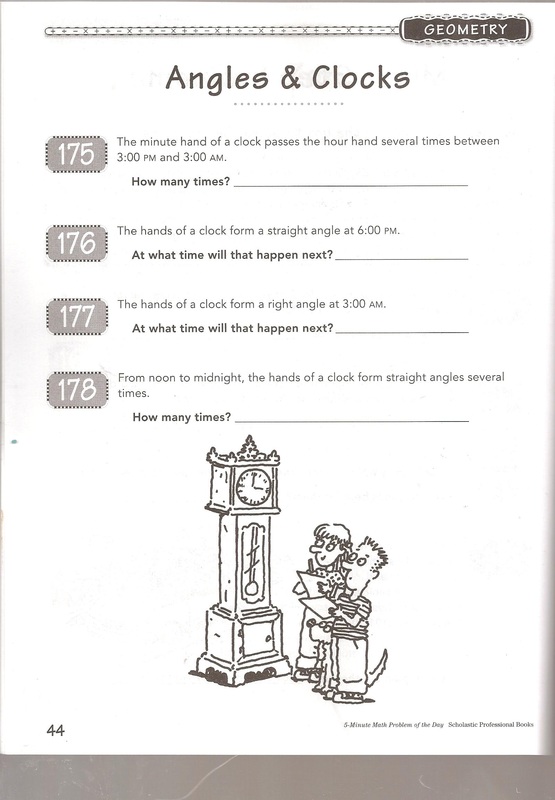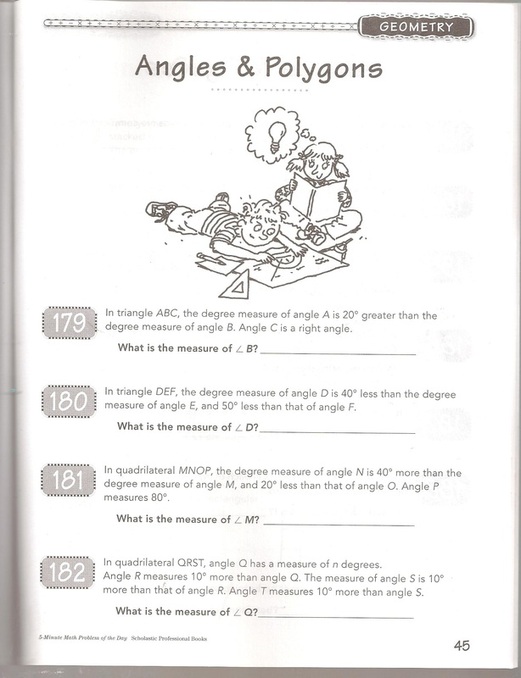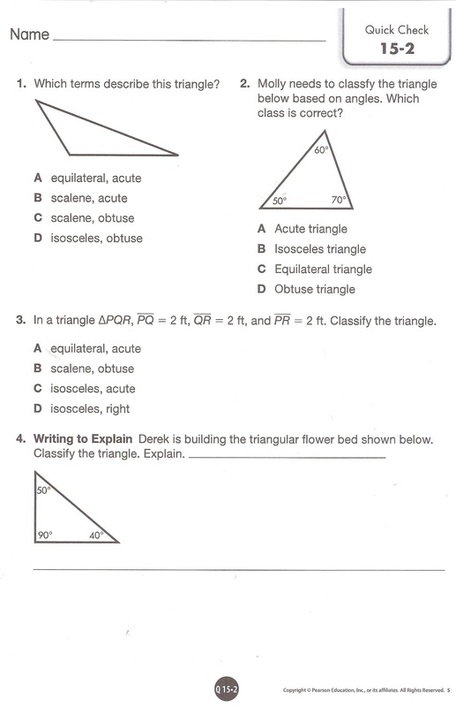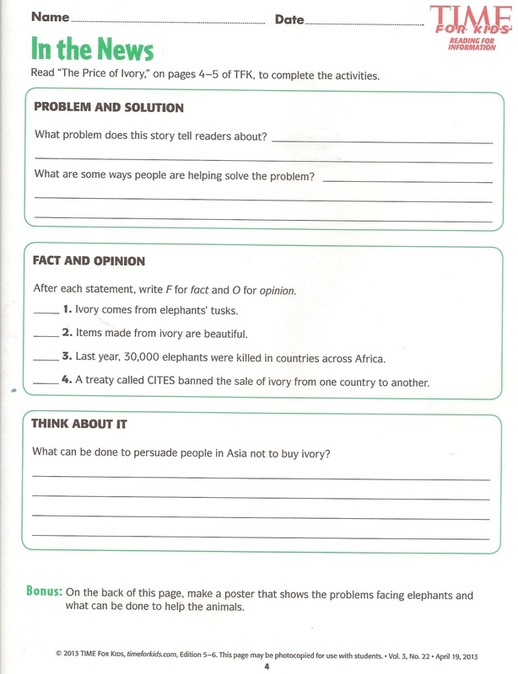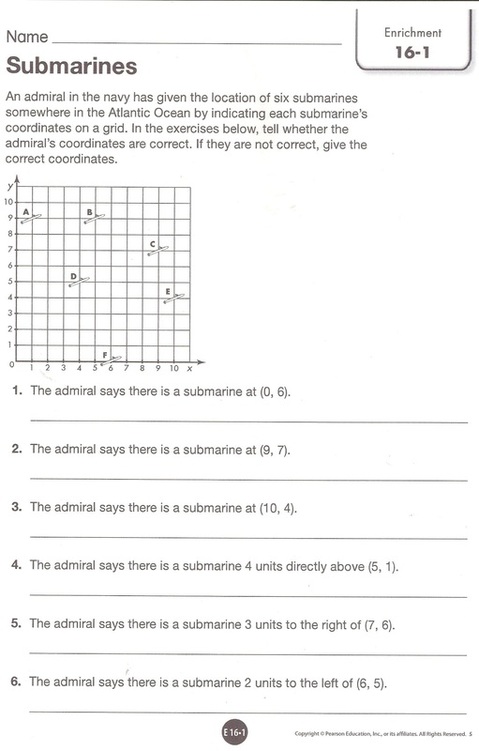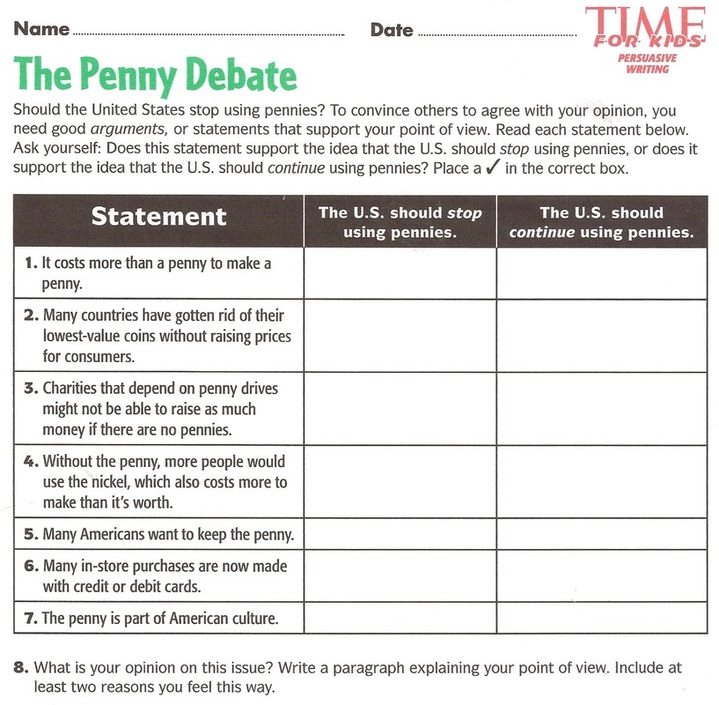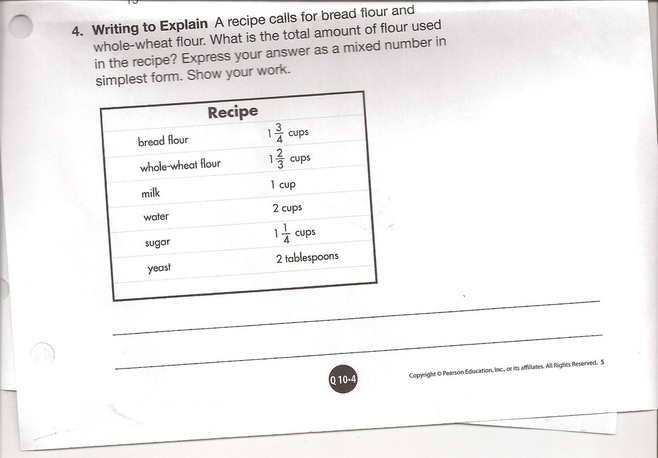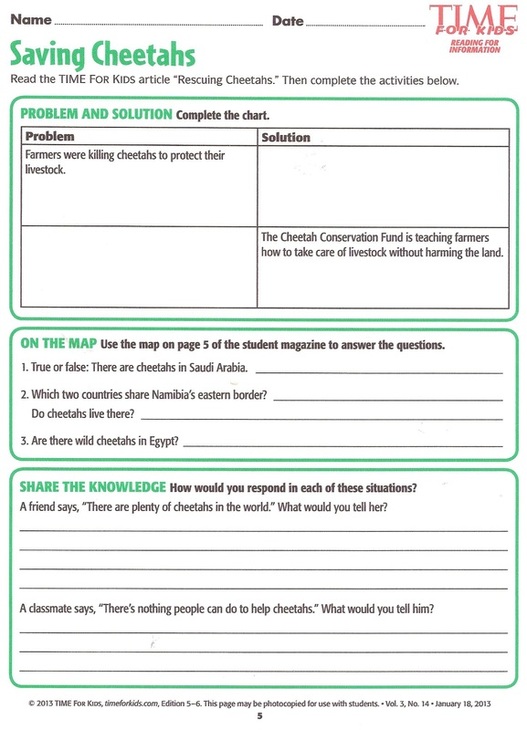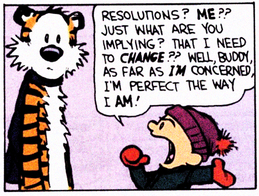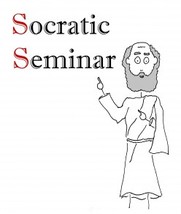CLASSWORK FOR TUESDAY MORNING-AFTERNOON:
TIME FOR KIDS COVER STORY: Top Secret?
Newspapers reveal details about top-secret government http://www.timeforkids.com/news/top-secret/95951
Write a summary and response to the story.
WORK ON CANADIAN WEBQUEST, BOOK CLUB PACKET #2 AND COMPLETE RESPONSE TO INSIDE HANA'S SUITCASE
MATH:
Problem of the day. “Fun with problem solving.” Great Grandma Gooseberry is having a bake sale. She had sold her pies by the slice. Each pie had 8 slices. A slice of gooseberry pie cost $2.75. A slice of blueberry pie goes for $3.50. Huckleberry pies are 2 slices for $5. In the first hour she sold 10 slices of gooseberry, 28 slices of blueberry and 5 slices of huckleberry. How much money did she make in the first hour? Show and explain your work.
Come up with your own math word problem involving the cost of food. It can be based on real prices or ones you make up. Keep it somewhat realistic and similar to the problem we worked on. Exchange with a partner.
Newspapers reveal details about top-secret government http://www.timeforkids.com/news/top-secret/95951
Write a summary and response to the story.
WORK ON CANADIAN WEBQUEST, BOOK CLUB PACKET #2 AND COMPLETE RESPONSE TO INSIDE HANA'S SUITCASE
MATH:
Problem of the day. “Fun with problem solving.” Great Grandma Gooseberry is having a bake sale. She had sold her pies by the slice. Each pie had 8 slices. A slice of gooseberry pie cost $2.75. A slice of blueberry pie goes for $3.50. Huckleberry pies are 2 slices for $5. In the first hour she sold 10 slices of gooseberry, 28 slices of blueberry and 5 slices of huckleberry. How much money did she make in the first hour? Show and explain your work.
Come up with your own math word problem involving the cost of food. It can be based on real prices or ones you make up. Keep it somewhat realistic and similar to the problem we worked on. Exchange with a partner.
MAN'S INHUMANITY TO MAN DEEP THINKING QUESTIONS:
| mansinhumanitydeepthinking.doc | |
| File Size: | 28 kb |
| File Type: | doc |
FRIDAY: THE WAVE CHAPTERS 5-6
Reflect and respond: DUE MONDAY
- What did the slogan, “Strength through Discipline” mean?
- What was the purpose of the exercises Mr. Ross gave the class?
- What is a motto? What was the purpose of the symbol, salute and motto?
- Do you think Mr. Ross should have informed his students or their parents about the real purpose of the Wave? Explain. What do you think would happen if a teacher conducted such an experiment in your school?
- Why do you think previous unmotivated students in Mr. Ross’ class were eager to participate in the Wave Exercises, discipline, motto and salute? Why do you think even the most passive students became active participants?
- Write your summary and response to these two chapters.
WEDNESDAY: THE WAVE CHAPTERS 3-4:
Reflect and respond:
- What troubled Laurie about her friendship with Amy? What did this reveal about Laurie’s character?
- What was the purpose of Mr. Ross’ research into the Nazi movement?
- What might the following passage foreshadow?: But that was the way Ben was. One summer she’d taught him to play bridge and within a month not only was he a better bridge player than she but he was driving her crazy, insisting that they play bridge every minute of the day. He only calmed down after he won a local bridge tournament and ran out of worthy competitors. It was almost frightening, the way he lost himself in each new adventure.
- Write a response and reaction to chapters 3-4.
TUESDAY:
The Wave—Interactive Read Aloud—Group One. Chapters One-Two. Vocabulary focus: conformity, desensitize, documentary, atrocity, perpetual.
Reflect and respond:
Reflect and respond:
- What did Mr. Ross think were his students’ shortcomings (weaknesses)?
- Why did he show his class a documentary about Nazi concentration camps? How did they react?
- Do you think high school students should be shown film footage of Nazi concentration camps? How would you react?
- Write your response to the first two chapters (include “wow” moments and any wonderings. Be prepared to share.
FRIDAY:
- In notebooks, reflect and respond to the following:
- A scapegoat refers to a person or group made to bear the blame for others or to suffer in their place. Under what situation do you think people look for scapegoats? Who are the individuals or groups that tend to become the victims of these situations?
- Analyze current fads-trends in the way students dress in your school. What brands of jeans and sneakers are currently in style? Do you think your classmates dress this way because of choice or peer pressure? What would happen if one person dressed in a completely different manner? Would that person be tolerated, pressured to conform or ostracized (picked on)? Explain.
- Todd Strasser the author says he writes for kids for several reasons: “First and foremost, I hope they will find my books helpful and entertaining as they go through the process of forming judgments and opinions on how they shall live. Do you think books are effective in helping people form judgments and opinions? Why or why not?
- Complete the Anticipation Guide and return to it following completion of the story.
THURSDAY:
Reread the Children’s Story. Write a written response to one idea presented in the story that struck your attention or one theme discussed during class. Provide textual evidence. Use information from the story to explain your thoughts. Be sure your response is about what you think and not just a summary of what you read. Include how and why Johnny changed. This story was written more than fifty years ago. Explain why it is still relevant. Also, include a discussion of why you think we are reading this story now. What relevance does it have to the Holocaust unit and to real life?
http://home.comcast.net/~llefler/clavell.htm
http://home.comcast.net/~llefler/clavell.htm
WEDNESDAY:
I will see you tomorrow. Please be good and do all of the following work today. Try to complete activities in your notebooks, in order to save paper.
Period One: Band-Time for Kids. Finish reading cover story from yesterday and completing activity sheet. In addition, reflect and respond to the following questions:
1. According to the article, what is
one reason to bring back extinct
animals?
2. What are some of the
possible risks?
3. Does the author think scientists
should or should not bring back
extinct species? What in the text
leads you to say that?
4. Focus on word choice. In paragraph 4,
the author writes, “Just because we
can bring species back from the dead
doesn’t mean that we should.” Ask:
Does this show that the author is
for bringing back species, against
bringing back species or neither?
5. Should extinct animals be brought
back? Write a paragraph
persuading others of their
opinion using information from
TFK. Include at
least one reason not given in the
cover story.
Period Two: Band kids complete Time for Kids activity. The rest: Read the following Science News story and write a summary (it should be a 2.00-3.00 summary--20-30 words along with your response that can be as long as you want.Scientists are working to produce meat without killing animals http://www.sciencenewsforkids.org/2012/04/meat-from-scratch/
Period Three: Work on Holocaust literary essays posted in reading workshop section.
Period Five: Current Events-Writing-Science: Read about tornado devastating Oklahoma town. http://www.timeforkids.com/news/tornado-devastates-oklahoma-town/93961Then read more about tornadoes here: http://www.weatherwizkids.com/weather-tornado.htm
Afterwards, write a response to the Oklahoma twister story and then write three new interesting facts they learned about tornadoes along with any reflections they wish to add about their new learning.
Periods Seven-Eight: problem solving activity sheets and if time, work on tessellations project. Homework is the same as yesterday. Have a great day.
Period One: Band-Time for Kids. Finish reading cover story from yesterday and completing activity sheet. In addition, reflect and respond to the following questions:
1. According to the article, what is
one reason to bring back extinct
animals?
2. What are some of the
possible risks?
3. Does the author think scientists
should or should not bring back
extinct species? What in the text
leads you to say that?
4. Focus on word choice. In paragraph 4,
the author writes, “Just because we
can bring species back from the dead
doesn’t mean that we should.” Ask:
Does this show that the author is
for bringing back species, against
bringing back species or neither?
5. Should extinct animals be brought
back? Write a paragraph
persuading others of their
opinion using information from
TFK. Include at
least one reason not given in the
cover story.
Period Two: Band kids complete Time for Kids activity. The rest: Read the following Science News story and write a summary (it should be a 2.00-3.00 summary--20-30 words along with your response that can be as long as you want.Scientists are working to produce meat without killing animals http://www.sciencenewsforkids.org/2012/04/meat-from-scratch/
Period Three: Work on Holocaust literary essays posted in reading workshop section.
Period Five: Current Events-Writing-Science: Read about tornado devastating Oklahoma town. http://www.timeforkids.com/news/tornado-devastates-oklahoma-town/93961Then read more about tornadoes here: http://www.weatherwizkids.com/weather-tornado.htm
Afterwards, write a response to the Oklahoma twister story and then write three new interesting facts they learned about tornadoes along with any reflections they wish to add about their new learning.
Periods Seven-Eight: problem solving activity sheets and if time, work on tessellations project. Homework is the same as yesterday. Have a great day.
WRITING TO EXPLAIN 15.2:
SCIENCE NEWS: http://www.sciencenewsforkids.org/2012/04/meat-from-scratch/
Science News for Kids: Meat from Scratch: Scientists are working to produce meat without killing animals http://www.sciencenewsforkids.org/2012/04/meat-from-scratch/
Write a summary and response to this story. (Try to have it be a 2.00-3.00 that includes the most important ideas. Response can and should be longer. (If you finish early, you may complete print and work on word search).
Write a summary and response to this story. (Try to have it be a 2.00-3.00 that includes the most important ideas. Response can and should be longer. (If you finish early, you may complete print and work on word search).
HOLOCAUST POETRY:
GREAT WEBSITE FOR SHAPE POEMS: http://www.tagxedo.com/app.html
| poetry_and_its_forms.doc | |
| File Size: | 58 kb |
| File Type: | doc |
REBEKKAH'S JOURNEY-WORLD WAR TWO REFUGEES
WRITE A RESPONSE TO THE STORY THAT INCLUDES A LIFE LESSON THAT IT TEACHES THE READER (INCLUDING TEXT EVIDENCE). JOT DOWN ANY NEW LEARNING AND WHAT IT MAKES YOU THINK OR WONDER ABOUT. INTEGRATE NEW LEARNING FROM THIS ARTICLE FROM THE NATIONAL HOLOCAUST MUSEUM:http://www.ushmm.org/wlc/en/article.php?ModuleId=10007094
RESPONSE TO THE CATS IN KRASINSKI SQUARE:
REFLECT AND RESPOND:
1. WHAT WAS THE MAJOR PROBLEM FACING THE NARRATOR, HER SISTER AND OTHERS INCLUDING PEOPLE FORCED IN THE WARSAW GHETTO?
2. HOW DID THIS GROUP OF YOUNG PEOPLE TRY TO SOLVE THE PROBLEM?
3. HOW WAS COURAGED DISPLAYED?
4. WHO ARE THE HEROES OF THIS STORY AND WHY?
5. WRITE A SHORT RESPONSE INCLUDING WHAT THIS NOVEL REALLY TEACHES YOU ABOUT LIFE WITH EVIDENCE. IN ADDITION, ANALYZE USING THE KOHLBERG MODEL WITH TEXTUAL EVIDENCE.
MONDAY, MAY 13: PROFILES IN COURAGE AND ALTRUISM DURING HOLOCAUST:
OSKAR SCHINDLER'S BRIEF STORY: http://teacher.scholastic.com/frank/miep.htm
http://myhero.com/go/hero.asp?hero=schindler_tauranga_NZ_2005
http://myhero.com/go/hero.asp?hero=schindler_tauranga_NZ_2005
CHOOSE YOUR OWN STORY TO RESPOND TO:
http://teacher.scholastic.com/frank/stories.htm
COMPLETE THIS ACTIVITY:
http://teacher.scholastic.com/frank/blmwrite.htm
http://myhero.com/go/hero.asp?hero=schindler_tauranga_NZ_2005
http://myhero.com/go/hero.asp?hero=schindler_tauranga_NZ_2005
CHOOSE YOUR OWN STORY TO RESPOND TO:
http://teacher.scholastic.com/frank/stories.htm
COMPLETE THIS ACTIVITY:
http://teacher.scholastic.com/frank/blmwrite.htm
TIME FOR KIDS WEDNESDAY: READ OCEAN OF WONDER COVER STORY AND COMPLETE QUESTIONS ON THIS ACTIVITY
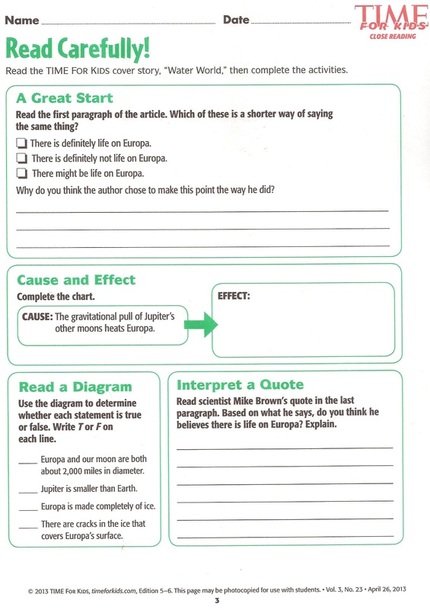
GOOD MORNING FOR FRIDAY, MAY 3RD:
I will see you all on Monday. Make sure you are prepared for Socratic seminar on identity and leave your published books in school. We will have our celebration on Monday, too. Please complete the following activities today:
Time for Kids: You will read together the cover story on elephants and complete the In the News activity. Please do not print. Just reflect and respond in your reading notebooks.
Science News for Kids: Read the following story on obesity and then write a summary and response in your reading or science notebooks: http://www.sciencenewsforkids.org/2011/04/new-study-shows-obesity-interferes-with-memory-thinking-and-reasoning/
Math: Complete page 395 and enrichment activity. If there's time, continue coordinate game from yesterday.
Work on Anne Frank and Holocaust book club packets.
HAVE A GREAT DAY AND BE GOOD!
Time for Kids: You will read together the cover story on elephants and complete the In the News activity. Please do not print. Just reflect and respond in your reading notebooks.
Science News for Kids: Read the following story on obesity and then write a summary and response in your reading or science notebooks: http://www.sciencenewsforkids.org/2011/04/new-study-shows-obesity-interferes-with-memory-thinking-and-reasoning/
Math: Complete page 395 and enrichment activity. If there's time, continue coordinate game from yesterday.
Work on Anne Frank and Holocaust book club packets.
HAVE A GREAT DAY AND BE GOOD!
THURSDAY: WHAT DO MAYAN LEGENDS TEACH US ABOUT STORY ELEMENTS AND ABOUT THEIR CULTURE?
WE WILL DO A SHARED READING OF THE MAYAN LEGEND, "HERO TWINS." WE WILL STOP AND JOT DIFFERENT STORY ELEMENTS WE LEARN FROM THIS STORY ALONG WITH DIFFERENT CULTURAL ASPECTS OF MAYAN SOCIETY WE GAIN INSIGHT ON. AFTERWARDS IN YOUR PARTNERSHIPS, READ YOUR OWN MAYAN LEGEND AND REFLECT AND RESPOND TO THE FOLLOWING QUESTIONS:
NAME OF MYTH-LEGEND:
WHAT IS THE THEME-LIFE LESSON?
I KNOW THIS BECAUSE...
WHO ARE THE MAIN CHARACTERS?
LIST TWO IMPORTANT CHARACTER TRAITS AND TRY TO INCLUDE EVIDENCE. FOR EXAMPLE, THIS CHARACTER IS _______ AND I KNOW THIS BECAUSE_____
WHAT IS THE BIG PROBLEM?
WHAT MAIN OBSTACLES ARE IN THE WAY?
HOW IS THE PROBLEM-CONFLICT FINALLY RESOLVED?
WHAT IS THE "BIG EVENT-MAJOR HAPPENING" THAT IS TAKING PLACE?
CULTURAL ASPECTS:
WHAT DO YOU LEARN ABOUT THE FOLLOWING BY STUDYING THE MYTH-LEGEND?
PLEASE USE THE FOLLOWING WEBSITES TO ASSIST YOU:
http://mayas.mrdonn.org/
http://www.mythicjourneys.org/bigmyth/
http://www.windows2universe.org/mythology/maya_culture.html
NAME OF MYTH-LEGEND:
WHAT IS THE THEME-LIFE LESSON?
I KNOW THIS BECAUSE...
WHO ARE THE MAIN CHARACTERS?
LIST TWO IMPORTANT CHARACTER TRAITS AND TRY TO INCLUDE EVIDENCE. FOR EXAMPLE, THIS CHARACTER IS _______ AND I KNOW THIS BECAUSE_____
WHAT IS THE BIG PROBLEM?
WHAT MAIN OBSTACLES ARE IN THE WAY?
HOW IS THE PROBLEM-CONFLICT FINALLY RESOLVED?
WHAT IS THE "BIG EVENT-MAJOR HAPPENING" THAT IS TAKING PLACE?
CULTURAL ASPECTS:
WHAT DO YOU LEARN ABOUT THE FOLLOWING BY STUDYING THE MYTH-LEGEND?
- CULTURE
- RELIGION
- GOVERNMENT
- ENVIRONMENT
- NATURAL RESOURCES AND HOW THEY ARE USED
PLEASE USE THE FOLLOWING WEBSITES TO ASSIST YOU:
http://mayas.mrdonn.org/
http://www.mythicjourneys.org/bigmyth/
http://www.windows2universe.org/mythology/maya_culture.html
MONDAY:
More aspects of Incan, Aztecs and Mayan Legends. Objective: What story elements as well as cultural aspects to Native American myths and legends teach us? http://incas.mrdonn.org/llamalegends.html
http://www.firstpeople.us/FP-Html-Legends/Legends-IL.html
http://www.mythicjourneys.org/bigmyth/myths/english/2_inca_full.htm
http://incas.mrdonn.org/mancocapac.html
Link: Not only do our myths and legends teach us important life lessons (themes), they help us focus on story elements and learn more about the Native American’s cultures. You will be working in partnerships reviewing different Incan legends. As you work together, please identify the following (students complete graphic organizer):
NAME OF MYTH-LEGEND:
STORY ELEMENTS: What is the theme-life lesson taught?
I know this because…
Who are the main characters?
List two important character traits for each main character and try to include evidence. For ex: This character is _____________ and I know this because ______________________
What is the big problem?
What main obstacles are in the way?
How is the problem-conflict finally resolved?
What is the “big event-major happening” that takes place?
CULTURAL ASPECTS:
What do you learn about the following by studying the myth-legend?
http://www.firstpeople.us/FP-Html-Legends/Legends-IL.html
http://www.mythicjourneys.org/bigmyth/myths/english/2_inca_full.htm
http://incas.mrdonn.org/mancocapac.html
Link: Not only do our myths and legends teach us important life lessons (themes), they help us focus on story elements and learn more about the Native American’s cultures. You will be working in partnerships reviewing different Incan legends. As you work together, please identify the following (students complete graphic organizer):
NAME OF MYTH-LEGEND:
STORY ELEMENTS: What is the theme-life lesson taught?
I know this because…
Who are the main characters?
List two important character traits for each main character and try to include evidence. For ex: This character is _____________ and I know this because ______________________
What is the big problem?
What main obstacles are in the way?
How is the problem-conflict finally resolved?
What is the “big event-major happening” that takes place?
CULTURAL ASPECTS:
What do you learn about the following by studying the myth-legend?
- Culture
- Religion
- Government
- Environment
- Natural resources and how they are used.
WRITING TO EXPLAIN FOR THURSDAY'S MATH:
It is recommended that people eat 25,000 mg of fiber each day. Jodi ate a cup of raspberries that had 8 grams of fiber and a cup of oatmeal that had 4 grams of fiber. How many more grams of fiber does she need to get the recommended daily amount of fiber. Show and explain your work.
THURSDAY: TIME FOR KIDS--A PENNY COVER STORY
Recall Facts and Details
••According to Mark Weller of
Americans for Common Cents,
what are three main reasons to
keep the penny?
••What is President Barack
Obama’s suggestion for lowering
the cost of penny production?
Make Inferences
••What are two possible reasons
that it costs more to make a
penny than a penny is worth?
ALSO COMPLETE THIS ACTIVITY SHEET, "THE PENNY DEBATE"--YOU CAN WRITE ANSWERS IN YOUR READING NOTEBOOK. YOU DO NOT HAVE TO PRINT IT OUT.
••According to Mark Weller of
Americans for Common Cents,
what are three main reasons to
keep the penny?
••What is President Barack
Obama’s suggestion for lowering
the cost of penny production?
Make Inferences
••What are two possible reasons
that it costs more to make a
penny than a penny is worth?
ALSO COMPLETE THIS ACTIVITY SHEET, "THE PENNY DEBATE"--YOU CAN WRITE ANSWERS IN YOUR READING NOTEBOOK. YOU DO NOT HAVE TO PRINT IT OUT.
WEDNESDAY: MATH-WRITING TO EXPLAIN (FINISH FOR HOMEWORK, IF NECESSARY)
MARGO HAS A RAIN BARREL THAT HOLDS 150 L OF RAINWATER. SHE USES THE RAINWATER FROM THE BARREL TO WATER HER PLANTS. IF SHE GIVES EACH PLANT IN HER GARDEN 500 mL OF WATER, HOW MANY PLANTS CAN SHE WATER WITH A FULL RAIN BARREL? SHOW AND EXPLAIN YOUR WORK.
WEDNESDAY: FINISH inca creation story: http://incas.mrdonn.org/mancocapac.html
WHAT DO YOU THINK THE PURPOSE OF THIS INCA CREATION STORY?
HOW WOULD THIS STORY AFFECT THE INCAS AND THE WAY THEY LIVE? BE SPECIFIC AND GIVE EXAMPLES.
AFTER INTERACTIVE READ ALOUD OF "SEEDS OF CHANGE," WRITE A RESPONSE IN YOUR READING NOTEBOOK:
• Seeds of Change is mostly a story about (summarize). At first, it may seem to be a lesson about (state a theme) with textual evidence. But then as I read on, I realized that it is really teaching me about…(provide textual evidence). Questions to ask yourself when thinking about theme and characters:
– How does the character change?
– What made him/her change?
– What lessons did the character learn?
– What are the characters’ feelings about what happens in the story?
– What conflicts do the characters engage in and what happens as a result?
– You do not have to answer these in question-answer format but instead, should respond in narrative form, answering these questions.
Use this link to a high order thinking skill website where questions are scaffolded from lowest to highest level. You should write a question from each level where you can then discuss in partnerships or in groups or if you like, share some as a whole class. http://campus.kellerisd.net/Teachers/25952/Classroom%20Information/Higher%20Order%20Thinking%20Questions.pdf
HOW WOULD THIS STORY AFFECT THE INCAS AND THE WAY THEY LIVE? BE SPECIFIC AND GIVE EXAMPLES.
AFTER INTERACTIVE READ ALOUD OF "SEEDS OF CHANGE," WRITE A RESPONSE IN YOUR READING NOTEBOOK:
• Seeds of Change is mostly a story about (summarize). At first, it may seem to be a lesson about (state a theme) with textual evidence. But then as I read on, I realized that it is really teaching me about…(provide textual evidence). Questions to ask yourself when thinking about theme and characters:
– How does the character change?
– What made him/her change?
– What lessons did the character learn?
– What are the characters’ feelings about what happens in the story?
– What conflicts do the characters engage in and what happens as a result?
– You do not have to answer these in question-answer format but instead, should respond in narrative form, answering these questions.
Use this link to a high order thinking skill website where questions are scaffolded from lowest to highest level. You should write a question from each level where you can then discuss in partnerships or in groups or if you like, share some as a whole class. http://campus.kellerisd.net/Teachers/25952/Classroom%20Information/Higher%20Order%20Thinking%20Questions.pdf
LINK TO ELA TEST PREP DAY THREE:
ON DEMAND TASK FOR COMPARATIVE ESSAYS: http://www.nysedregents.org/Grade6/EnglishLanguageArts/samplebook3.pdf
On Demand Task for Comparative Essays Using: Last Kiss and Growing Pains
Read The Short Story Last Kiss by Ralph Fletcher and the poem Growing Pains by
Jean Little. You will use the two passages to compare and contrast the text with
similar themes hand develop a thesis/ claim that applies to both stories and a
common message.
In your response, be sure to:
- Introduce a topic
- use details from the stories to support your answers
- Organize ad connect your ideas in your writing
- Provide a closing statement in your writing
- Use transition words
- Check your writing for complete sentences, capitalization, punctuation and
Spelling.
Read The Short Story Last Kiss by Ralph Fletcher and the poem Growing Pains by
Jean Little. You will use the two passages to compare and contrast the text with
similar themes hand develop a thesis/ claim that applies to both stories and a
common message.
In your response, be sure to:
- Introduce a topic
- use details from the stories to support your answers
- Organize ad connect your ideas in your writing
- Provide a closing statement in your writing
- Use transition words
- Check your writing for complete sentences, capitalization, punctuation and
Spelling.
WE WILL WORK ON THIS IN CLASS ON FRIDAY, FEBRUARY 22:
FRIDAY MORNING SCIENCE ARTICLE:
Read landforms article. Reflect and respond in your reading or science notebook:
- What is a barrier island?
- How do dunes form?
- How do floods occur?
- According to the article, how does erosion-deposition change shorelines?
- How doe the author show that floods can be minimized or prevented?
- How do landforms protect against natural disasters?
- How can areas with no natural wetlands be affected more harshly during a storm?
- Thinking about the information in the article, how can we protect against flooding or shorelines against erosion?
- What will happen to shorelines if erosion continues?
SOCIAL STUDIES: WESTWARD EXPANSION: PLEASE GO TO THE FOLLOWING LINK ALL ABOUT THE GOLD RUSH:
Write a 30-40 word summary and response to what you have learned. Be sure to include at least two new important and interesting facts. Tell what it makes you think or wonder about for each one.
MATH ORDER OF OPERATIONS WEBQUEST:
FRIDAY: SAVING CHEETAHS-COMPLETE AND DISCUSS AFTER READING TFK COVER STORY
PODCASTING CLUB:
Great links to the program: http://teachhumane.org/heart/
http://kidsforheart.org/
FYI: Article on child labor (what was covered in Thursday's lesson): http://www.scholastic.com/teachers/article/history-child-labor
Think about how you would like to present some of the information to a listening audience.
What details about the program would you like to include?
What messages about the program would you like to include?
What would you like to share from class activities and lessons?
What resources (from HEART including the kids' sections) would you like to share with your audience about?
Consider you want to provide an overview-summary along with your personal response and how other kids who are in the program feel about it.
Who do you think should be interviewed about the program?
For now, just start perusing and looking over some of the resources on the websites to get yourself familiar with the program.
Start jotting down your responses to the lessons and what you are learning about the different resources.
http://kidsforheart.org/
FYI: Article on child labor (what was covered in Thursday's lesson): http://www.scholastic.com/teachers/article/history-child-labor
Think about how you would like to present some of the information to a listening audience.
What details about the program would you like to include?
What messages about the program would you like to include?
What would you like to share from class activities and lessons?
What resources (from HEART including the kids' sections) would you like to share with your audience about?
Consider you want to provide an overview-summary along with your personal response and how other kids who are in the program feel about it.
Who do you think should be interviewed about the program?
For now, just start perusing and looking over some of the resources on the websites to get yourself familiar with the program.
Start jotting down your responses to the lessons and what you are learning about the different resources.
MONDAY--GRAFFITI--ON-DEMAND PRE-ASSESSMENT
After you complete post assessment features on blizzards, please begin your on-demand pre-assessment for our opinion-persuasive writing unit. Please read the following articles:
http://secondavenuesagas.com/2009/04/15/the-graffiti-debate-glorifying-art-or-vandalism/
http://classroom.wsj.com/cre/2011/10/01/art-or-vandalism/
http://teenink.com/hot_topics/environment/article/297436/Graffiti-Art-or-Vandalism/
http://www.theartnewspaper.com/articles/Graffiti-is-it-art-or-vandalism/28040
TASK: Students will write a persuasive essay stating a claim about how they feel about Graffiti, is it Art Or Vandalism and support it with research from multiple sources.
You will read several texts about Graffiti. Integrate information from the texts to write a well-organized persuasive essay in which you state an opinion about whether or not you believe that Graffiti is art or vandalism. In your essay, be sure to introduce the topic
clearly and support your opinion with facts, details, and quotations from the resources studied in class. Use transition words and phrases to link ideas about the topic. Include content-specific vocabulary when writing to support the topic. Include a closing statement related to the topic.
http://secondavenuesagas.com/2009/04/15/the-graffiti-debate-glorifying-art-or-vandalism/
http://classroom.wsj.com/cre/2011/10/01/art-or-vandalism/
http://teenink.com/hot_topics/environment/article/297436/Graffiti-Art-or-Vandalism/
http://www.theartnewspaper.com/articles/Graffiti-is-it-art-or-vandalism/28040
TASK: Students will write a persuasive essay stating a claim about how they feel about Graffiti, is it Art Or Vandalism and support it with research from multiple sources.
You will read several texts about Graffiti. Integrate information from the texts to write a well-organized persuasive essay in which you state an opinion about whether or not you believe that Graffiti is art or vandalism. In your essay, be sure to introduce the topic
clearly and support your opinion with facts, details, and quotations from the resources studied in class. Use transition words and phrases to link ideas about the topic. Include content-specific vocabulary when writing to support the topic. Include a closing statement related to the topic.
THURSDAY, JANUARY 3RD-POST-ASSESSMENT-FEATURES-BLIZZARDS:
BLIZZARDS:
Prepare a feature article on blizzards. Keep in mind everything we have studied during this unit. Try to utilize as many features of features as possible and keep in mind what you know about great leads, big bang endings, voice, second person narrative, photos, captions, sidebars, etc. You may use the feature rubric to guide your writing. Use the following resources to help construct your pieces (but feel free to use others—just try to avoid Wikipedia, for now):
Prepare a feature article on blizzards. Keep in mind everything we have studied during this unit. Try to utilize as many features of features as possible and keep in mind what you know about great leads, big bang endings, voice, second person narrative, photos, captions, sidebars, etc. You may use the feature rubric to guide your writing. Use the following resources to help construct your pieces (but feel free to use others—just try to avoid Wikipedia, for now):
- Watch video with headphones: http://www.history.com/videos/science-of-a-blizzard#science-of-a-hurricane
- http://www.scholastic.com/teachers/article/snow-and-blizzards
- http://teacher.scholastic.com/activities/wwatch/winter_storms/
- http://www.kidskonnect.com/subjectindex/15-educational/science/64-blizzard.html
WEDNESDAY, JANUARY 2ND: We will work on New Year's Resolutions, hopes-visions for the world in 2013 along with setting new academic goals. Please see attachment.
| choosing_goals_for_ourselves.doc | |
| File Size: | 44 kb |
| File Type: | doc |
BACTERIA: THE GOOD, THE BAD & THE STINKY:
(Labeled) Question-Answer-Relationships
1. Question: What are bacteria?
a. Answer:
b. QAR: Right There (The answer is a direct quote from the text.)
2. Question: What are the three kinds of bacteria described in the
a. passage and what are some of the things they do for (and to)
b. us?
c. Answer:
d. QAR: Think and Search (Reader must select information from
e. several paragraphs in the text.)
3. Question: How do the “geeky” bacteria create body odor? How can it be prevented?
a. Answer:
b. QAR: Author and Me (Reader must know the function and properties of bacteria and be able to use background knowledge of basic hygiene to infer the answer.)
4. Question: If antibiotics are effective in destroying bacteria, why
a. do you think doctors warn against using them every time we get sick?
b. Answer:
c. QAR: On My Own (Reader may rely almost entirely on prior knowledge; little or no knowledge of the text is required.)
5. Answer the following questions and identify the QAR you used to find the answer.
6. Question: Describe three ways “bully” bacteria may spread.
a. Answer:
b. QAR:
7. Question: If you were a manager at McDonald’s, how would
i. you ensure that workers keep their hands clean, especially
ii. after going to the bathroom?
iii. Answer:
iv. QAR:
8. Question: What are microbes?
a. Answer:
b. QAR:
9. Question: What was the author’s purpose in writing this article?
a. Answer:
b. QAR:
10. Why does the author ask for a “round of applause for bacteria?
11. In terms of author’s craft, what do you notice about voice, word choice, figurative language, lead and ending? (Be specific!)
1. Question: What are bacteria?
a. Answer:
b. QAR: Right There (The answer is a direct quote from the text.)
2. Question: What are the three kinds of bacteria described in the
a. passage and what are some of the things they do for (and to)
b. us?
c. Answer:
d. QAR: Think and Search (Reader must select information from
e. several paragraphs in the text.)
3. Question: How do the “geeky” bacteria create body odor? How can it be prevented?
a. Answer:
b. QAR: Author and Me (Reader must know the function and properties of bacteria and be able to use background knowledge of basic hygiene to infer the answer.)
4. Question: If antibiotics are effective in destroying bacteria, why
a. do you think doctors warn against using them every time we get sick?
b. Answer:
c. QAR: On My Own (Reader may rely almost entirely on prior knowledge; little or no knowledge of the text is required.)
5. Answer the following questions and identify the QAR you used to find the answer.
6. Question: Describe three ways “bully” bacteria may spread.
a. Answer:
b. QAR:
7. Question: If you were a manager at McDonald’s, how would
i. you ensure that workers keep their hands clean, especially
ii. after going to the bathroom?
iii. Answer:
iv. QAR:
8. Question: What are microbes?
a. Answer:
b. QAR:
9. Question: What was the author’s purpose in writing this article?
a. Answer:
b. QAR:
10. Why does the author ask for a “round of applause for bacteria?
11. In terms of author’s craft, what do you notice about voice, word choice, figurative language, lead and ending? (Be specific!)
ORPHAN TRAINS QUOTE RESPONSE (MAKE SURE TO INCLUDE IN YOUR ORPHAN TRAIN PACKET):
WHAT IS THE MEANING OF THE LAST QUOTE AND WHY DID THE VIDEO END WITH THIS: "Back when he began, Brace said, "When a child of the streets stands before you in rags, with tear-stained face, you cannot easily forget him, and yet you are perplexed what to do. The human soul is difficult to interfere with. You hesitate how far you should go."
SOCRATIC SEMINAR: WE WILL BEGIN SOON IN CLASS!
| socratic_seminar.ppt | |
| File Size: | 1106 kb |
| File Type: | ppt |
